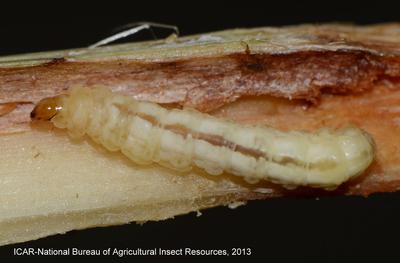White Top Borer
Scirpophaga excerptalis
Insect
In a Nutshell
- Dead heart.
- Series of parallel holes across the leaf.
- Internal feeding of stems, growing points and leaves.
- Silvery white moth.
Can also be found in
Symptoms
A series of parallel holes across the leaf blade when it unfolds is an apparent symptom of the borers activity. The leaf midribs have brown dried tunnels that is the most characteristic symptom to identify the early stage of attack. Egg clusters are present on the upper leaf side close to the growing point. Growing points are attacked, killing the stalk. Canes get dead heart and are reddish brown colored. The top shoot will become withered and stunted. Due to the growth of side shoots the plant appears bunchy. Small holes can be observed in the stem near the ground level. Only one larva is feeding inside in a single tiller.
Recommendations

Organic Control
Release of egg parasitoid like Trichogramma chilonis @ 10,000/ha 2-3 times at 10 days interval or ichneumonid parasitised Gambroides (isotima) Javensis (100pairs/ha) can be introduced as perpetual parasitoid.

Chemical Control
Always consider an integrated approach with preventive measures together with biological treatments if available. Broadcast insecticides like carbofuran 5% G (33.3 kg/ha), or spray chlorantraniliprole 18.5% SC (375 ml/ha). Application can be done by opening a small furrow near the root zone, placing the granule of carbofuran, followed by a light irrigation. However, manual operation of cutting the young affected tiller is most effective.
What caused it?
Damage is done by the Sugarcane White Top Borer, Scirpophaga excerptalis. The adult moth has silvery white wings with feathery tips. The female lays eggs that are covered in yellow-brown hairs or puffs. The larvae tunnel through rolled leaves, causing the described damage. Larvae are about 35 mm long, with creamy white or yellow and brown head, devoid of stripes, with atrophied legs. They feed further along the midrib into the heart of the plant. The thirds generation causes the highest losses in sugar cane. Young plants are most prone to the pest especially in humid environments.
Preventive Measures
- Use tolerant or resistant varieties like CO 419, CO 745, CO 6516, CO 859, CO 1158 or CO 7224 if available.
- Paired row systems are preferred for planting.
- Intercrop with non host crops like spices or pulses.
- Do not use maize, sorghum as intercrops.
- Place 2-3 pheromone traps per ha in your field to monitor the adult moths.
- Install light or pheromone traps with exit option for natural enemies 2 for 5 ha.
- Alternatively install aerial nets in the morning or during the twilight.
- Remove affected plant parts.
- Collect the egg masses during oviposition.
- Also, destroy dead hearts during 2nd brood period.
- Conserve natural predators and parasitoids.



